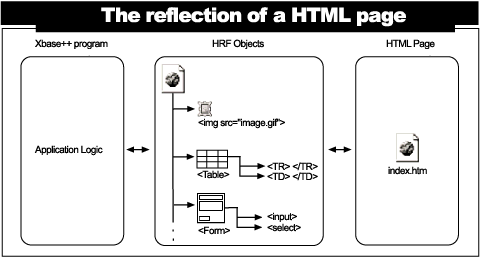HRF Programmer's Guide Professional
The HTML Reflection Framework (HRF) is an implementation of the Document Object Model 1.0 (DOM) specification of the W3C (see http://www.w3c.org). The HRF is implemented as an Xbase++ class-model reflecting any HTML document and its contents. The HRF includes an object generator which can parse a HTML page and reflect it via a collection of objects. This enables Xbase++ developers to transparently manipulate HTML documents on the PRG source code level. Similar to the Parent/Child relationship of Xbase Parts, the structure of a HTML document is represented as a tree structure of objects. This is illustrated in the following picture.

The driving force for the development of the HRF is the increasing demand for creating/modifying HTML documents with dynamic content. Publishing frequently changing data on-time, for example, requires tables to be modified in HTML documents, rows/cells in tables must be added/removed or their content must be changed, etc. This imposes a continuously increasing complexity for Web site administration which can be eased by connecting database and Internet technology. The major design goals for the HRF are therefore:
The advantages of the HTML Reflection Framework are:
If you see anything in the documentation that is not correct, does not match your experience with the particular feature or requires further clarification, please use this form to report a documentation issue.